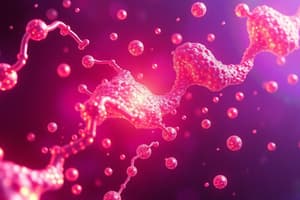Podcast
Questions and Answers
What is the purpose of adding Millon's reagent to the test solution in this experiment?
What is the purpose of adding Millon's reagent to the test solution in this experiment?
- To complex mercury ions with nitrated tyrosine
- To cause burns in the test solution
- To nitrated the tyrosine in the test solution
- To provide a positive test by creating a red color (correct)
Why should excess of Millon's reagent be avoided in the test procedure?
Why should excess of Millon's reagent be avoided in the test procedure?
- To enhance the specificity of the test for proteins
- To promote the formation of a yellow color
- To prevent the formation of a non-positive yellow color (correct)
- To speed up the reaction with tyrosine
What is the significance of the appearance of a brick-red color in this experiment?
What is the significance of the appearance of a brick-red color in this experiment?
- It confirms the presence of proteins
- It indicates a negative result
- It serves as a positive test result (correct)
- It signifies the presence of gelatin
Why is Millon's test not specific for proteins?
Why is Millon's test not specific for proteins?
What differentiates proteins that initially form a white precipitate from those that form a red solution immediately in this test?
What differentiates proteins that initially form a white precipitate from those that form a red solution immediately in this test?
Why does gelatin give negative results in this test?
Why does gelatin give negative results in this test?
What is the purpose of the Xanthoproteic test?
What is the purpose of the Xanthoproteic test?
Which of the following amino acids are considered aromatic based on the text?
Which of the following amino acids are considered aromatic based on the text?
Why do aromatic amino acids undergo nitration with nitric acid in the Xanthoproteic test?
Why do aromatic amino acids undergo nitration with nitric acid in the Xanthoproteic test?
What color change is observed when the nitro phenyl group reacts during the Xanthoproteic test?
What color change is observed when the nitro phenyl group reacts during the Xanthoproteic test?
Why does Phenylalanine not respond to the Xanthoproteic test despite containing a benzene ring?
Why does Phenylalanine not respond to the Xanthoproteic test despite containing a benzene ring?
What is the color of the solution when a strong base like NaOH is added in the Xanthoproteic test?
What is the color of the solution when a strong base like NaOH is added in the Xanthoproteic test?
What does the formation of a yellow color upon heating in a boiling water bath indicate in the xanthoproteic test?
What does the formation of a yellow color upon heating in a boiling water bath indicate in the xanthoproteic test?
Why should NaOH be added cautiously after heating and cooling the protein sample in the xanthoproteic test?
Why should NaOH be added cautiously after heating and cooling the protein sample in the xanthoproteic test?
Which amino acid is common in giving a positive reaction in Millon's test due to its phenolic group?
Which amino acid is common in giving a positive reaction in Millon's test due to its phenolic group?
What is the purpose of heating in Millon's test when using Millon's reagent on a protein sample?
What is the purpose of heating in Millon's test when using Millon's reagent on a protein sample?
Why does gelatin typically give only a faint color or negative result in the xanthoproteic test?
Why does gelatin typically give only a faint color or negative result in the xanthoproteic test?
What is the role of nitric acid (HNO3) in the xanthoproteic test when testing protein samples?
What is the role of nitric acid (HNO3) in the xanthoproteic test when testing protein samples?
Flashcards are hidden until you start studying
Study Notes
Millon's Test
- Millon's reagent detects phenolic compounds, commonly found in proteins like tyrosine.
- Excess Millon's reagent can lead to false positives, overly complicating results.
- A brick-red color indicates the presence of tyrosine, signifying a positive result.
- Millon's test lacks specificity for proteins, as it can also react with other phenolic compounds.
Xanthoproteic Test
- The Xanthoproteic test identifies aromatic amino acids, such as phenylalanine, tyrosine, and tryptophan.
- Aromatic amino acids undergo nitration with nitric acid, allowing the formation of a yellow nitro derivative.
- A color change to yellow occurs when the nitro phenyl group reacts.
- Despite containing a benzene ring, phenylalanine does not respond to the Xanthoproteic test due to its structure.
- The addition of NaOH turns the solution yellow, confirming the presence of nitrated amino acids.
- A yellow color after heating indicates the presence of aromatic compounds.
- NaOH should be added cautiously to avoid saponification or degradation of proteins after heating and cooling.
- Tyrosine is notable for giving a positive Millon’s test reaction due to its phenolic group.
- Heating increases reagent reactivity, facilitating the Millon’s test result interpretation.
- Gelatin gives negative outcomes in the Xanthoproteic test because it lacks aromatic amino acids.
- Nitric acid (HNO3) plays a critical role in the Xanthoproteic test by converting aromatic amino acids into nitro derivatives, aiding in detection.
Studying That Suits You
Use AI to generate personalized quizzes and flashcards to suit your learning preferences.




